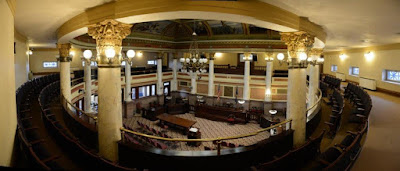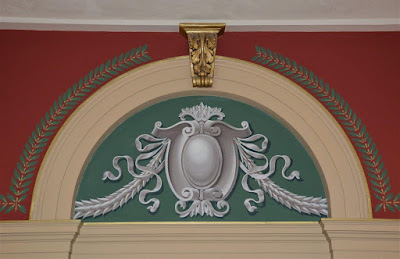State Capitols – Helena, Montana – Part 2
June 17, 2014
The Montana state house is interesting enough for a second post, especially since it has an art story as compelling as the one from the House of Representatives Lounge in the Missouri capitol. The saga where Thomas Hart Benton prevailed over the hypocrite pols was presented here in March 2020.
I returned to the capitol the following morning and took the tour. Sometimes you hit the jackpot and get a terrific guide. Dallas Miller, a retired history professor, showed us around. He even got us into the legislative chambers on the floor level.
Beginning in January of every odd-numbered year, the legislature meets in regular session for ninety working days. The state is divided into 100 House districts for the purpose of representation. Senate members are half that number with two House districts represented by each senator. The Senate’s 50 members are elected to four-year terms. Half the positions are up for a vote every two years.
Given to the capitol by the Northern Pacific Railroad, this mural is the only art work not commissioned by the state. It commemorates the completion of the northern transcontinental rail line in 1883 with former president Ulysses Grant driving in the final spike. Mr. Miller noted that this was the first time a former president was paid ($2000) to make an appearance.
The House has 100 members, each elected for 2-year terms. One is immediately drawn to the painting at the front of the room. Charles M. Russell was one of the premier artists of the old west and a Montana resident. In 1911, he was commissioned to paint what many consider his masterwork. The 25 x 12-foot mural is said to be worth $40-65 million…not bad given the commission was $5000. Russel had to raise the roof of his cabin studio to accommodate the canvas.
Professor Miller’s pitch might have been short on the history of the state and the building, but it was long on Lewis and Clark, Sacajawea and the great painting that occupies the entire front of the House chamber.
For an artist that had to be talked out of his original suggestion – to depict a Native attack on a wagon train, his final product defied convention in other ways. The title characters are reduced to a minor depiction on the far-right background, while the center is dominated by Indians and the prairie…as if to convey whose land it was before the state was established.
We were directed to one particular part of the painting…near the center of the foreground is a snarling wolf. Apparently, Russell didn’t care much for the Speaker of the House. It was his eternal joke to have a vicious predator forever eyeing the person at the central rostrum.
On Professor Miller’s telling, when Russell’s wife (and business manager, Nancy) learned of the insult, she made him go to the Speaker’s house (they lived in the same county) and personally apologize. From what I’ve read, Nancy should get as much credit for Charlie’s success since she worked hard to straighten out his undisciplined ways and promote his work.
Surprisingly, the Speaker didn’t mind the insult. He and the artist visited for hours and became fast friends. He wound up eulogizing Russell at his funeral.
After Helena, we drove through Yellowstone National Park to end the trip at the Utah capitol in Salt Lake City. This will be the last post for the year. I wish you and yours a safe, healthy and happy holiday and that we never again experience another holiday and year like 2020.























